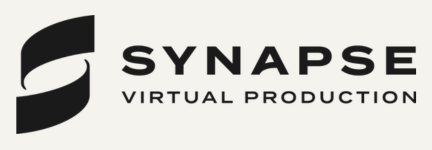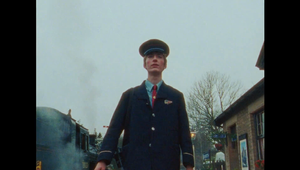
Focus, Discipline, Efficiency: The Other Reasons Filmmakers Opt for the Analogue Medium

Above: BTS from 'Find Your Pace' spot, shot on 65mm
There’s a myth among non-filmmakers that shooting on film doesn’t have the same efficiency, the same immediacy that digital tools provide. Used as many of us are to the process of picking up a phone and capturing an image instantly, we think it must be the same for film professionals and their digital cameras. The inverse, ironically, is true. Just as taking a picture on a phone so often becomes about that process, taking the person behind the lens out of the moment and gluing them to the screen – not what’s beyond it, so does shooting digitally. Or so filmmakers are telling us of their experiences, praising the analogue medium as much for the efficiencies it begets on set as for its unrivalled aesthetic qualities.
Cinematographer Jake Gabbay says that shooting on film “often elevates the focus on set. Not always, but certainly more often than not.” For director Albert Moya, shooting in film requires a different kind of focus. “It forces you to slow down and consider what you’re capturing, the framing, the light, the movement, all of it becomes more intentional. That process requires a higher level of clarity and precision, which sharpens your instincts as a filmmaker. It reminds you that every frame really counts.”
Above: Travis Scott's '4x4', shot by Jake Gabbay
Ben Fordesman, cinematographer, echoes the sentiments, saying, “Shooting film demands a laser focus on set, I suppose we all sharpen our attention and become way more competent at our jobs. There’s just a charged feeling that never gets old. You know the results will always be reliably magical: skin tones, colours and grain embellished in a way that defines the look of the film, and makes the colour grade process feel nearly effortless.”
The limits imposed by the on set availability of film stock (and the costs) create “a sense of preciousness when the camera rolls, since you can’t just shoot endlessly like you can with digital. That added sense of purpose can help everyone lock in, and I think that heightened focus naturally supports the rhythm of the set,” adds Jake.
What appears to be a limitation is actually an imposed structure that filmmakers report, over and over again, to enjoy. For Ramez Silyan, shooting on film limits “the exposure to just what you intend, rather than what sometimes happens with digital – where the language often feels scientific and the focus is on capturing as much "data" as possible.” The on-set experience of filmic productions, and the results, are what continue to draw Ramez to the medium. “As a finite resource, film demands technical expertise and precision while also protecting the image, as very few are privileged to see through the eyepiece. This allows focus to be on performance, rather than getting into the weeds over an image that can always be refined in post,” he says.
The first time director Eugen Merher shot on 16mm, for the short film ‘motoclista’, was in extreme conditions. He was in Uruguay with cinematographer Diego Rosenblatt. He recalls working with “grimy, old school monitors, no proper dailies, no safety net.” While the experience “was scary,” says Eugen, “it taught me something important: To stop obsessing over technical perfection (which I tend to do with digital shoots) and instead trust my collaborators, be with the actors, and focus on what’s actually happening in front of the camera.”
Above: 'motoclista', directed by Eugen Merher
That lesson stayed with him when he was confronted with another challenging on-set situation, working with a child actor for Rudimental’s ‘Dancing is Healing’ music video. “Though Iona was a ridiculously talented actress, I didn’t want to burden the shoot with too much repetition or over-control.” That’s where the film format became an advantage. “Knowing that the material was limited made us shoot quicker: two, maybe three takes max. We got way more scenes on camera than if we were shooting on digital. No video village, no second-guessing. Just a handheld camera, a few rolls of film, and full attention on what was unfolding in front of us,” Eugen says.
Jake has noticed that a “major difference” of film shoots is “people can’t see a ‘finished’ image on a monitor. That limitation actually becomes a strength, it keeps distractions to a minimum and lets us focus more on the performance and the energy of the scene. It creates a space where I can concentrate fully on exposure and light, and I’m trusted to do that based on the conversations I’ve had with the director. That trust and simplicity can be really efficient in its own way.”
A piece of filmwork is always a product of collaboration yet on a film shoot, collaboration gains another dimension. Albert says that sense is simply “stronger”, adding “on set, everyone is more present, aware of the care behind each take. There’s a certain respect that comes with shooting on film. It elevates the energy and reminds everyone that we’re creating something lasting, where every shot is intentional and every role truly matters.”
Jake says there’s “more structure and rehearsal before we roll” on a film shoot and it produces “a bit more collective mindfulness – everyone is aware that each take carries more weight.” The awareness often translates to more intentionality in pre-production and on the shoot too though “that kind of preparation can happen with digital too.” Still, in Jake’s experience, “there’s just something about the limitations of film that brings a deeper level of focus to the collaboration.”
Director Courtney Phillips has “loved shooting on film since early in my directing days.” He adds, “It started with gritty Bolex B-roll to offset the clean look of digital but, over time, I started telling full stories on 16mm and 35mm and came to love not just the image quality, but the restraint it brings. With limited stock, every shot counts.”
Above: McDonald's 'Showdown 2.0', directed by Anthony Jamari Thomas
For director Anthony Jamari Thomas, who shot the Angel Reese McDonald’s campaign (“The first commercial project where 35mm film was requested by agency and client!”), finds film to be a “process of patience which adds a level of intensity to the workflow,” calling the trade-off “huge.”
Jake draws attention to another benefit he reaped from working on film: the sharpening of craft. “[I] truly started to understand lighting and exposure once I began shooting on film,” he states. Because there’s no reliance on a monitor “you have to build the image in your head – based on the light, the metre readings, and your instincts,” he adds. In the film shooting process, Jake has to “metre every light source and mentally construct how the final image would look. Then, I have to wait. And during that waiting period, I replay the scene over and over in my mind. That whole process was incredibly important to my development, it forced me to become more deliberate and technically sharp,” he says of the care and intentionality required to create every scene.
Above: H&M's SS24 campaign, directed by Albert Moya, processed and scanned at Cinelab Film & Digital
Because so much care and planning goes into the preparation and the production process for a film shoot, it has a positive influence on post-production too. In short, there’s a lot less to fix in post. Director Elliott Power attests to this, saying “film sets the tone from the start.” With film’s “baked-in look and discipline on set, post becomes more about refining than fixing. It guides the edit with intention and makes grading feel like sculpting, not salvaging.”
“When it comes to grading, film makes a huge difference,” says Jake. As a cinematographer, he can feel “confident that what I shoot on film will be consistent; it delivers the image I expect based on the choices I’ve made. With digital, that consistency just isn’t the same. You’re relying more on LUTs, monitors, and the post process, and those variables can shift depending on the camera or setup.” With film, there’s certainty, Jakes knows “what I’m going to get. That trust and control are a big reason why I feel so much more at home shooting film than digital.”
Another prolific film aficionado is the director Sean Baker (of the Oscar-winning ‘Anora’) and he’s recently purchased two cameras – an ARRI LT 35mm, and a 16mm ARRI SR3 – “knowing that we'd be shooting on film for the rest of my career,” he told A Rabbit’s Foot magazine, restating his commitment to the medium. To date, four of Baker’s five major features have been shot on film.
He went on to describe the mood on set when the production is working with film and the reverence everyone feels towards the medium. “And then there's the discipline that happens on set when you tell actors that you're shooting on film. Their faces light up. Because suddenly your actors are feeling the pressure now. They know it's a 10-minute mag, and we'll be calling cut no matter what when that time runs out. It's about delivering in the moment, and having a finite amount of chances to do so,” Baker is quoted as saying in A Rabbit’s Foot.
Elliott likewise sees the value of the demanding medium in that it asks everyone to do their best, bringing “precision, patience, and purpose.” He’s resolute that the process creates better filmmakers and offers advice to anyone starting out. “It trains your eye, your timing, and your storytelling instincts. For young filmmakers: shoot on film whenever you can. It’s the best crash course in making every frame count.”
For Baker, like all the filmmakers LBB spoke to, digital is a great option to have but it’ll never give productions what film can. Why? Baker says it best. “If you have the means, shoot on film, it'll elevate your project. Whether someone knows it or not, the classic film look will be felt unconsciously. After 100 years, we connect that look with what cinema is in its purest form.”















